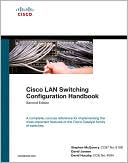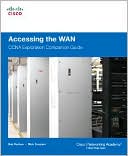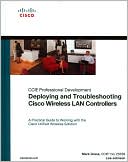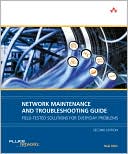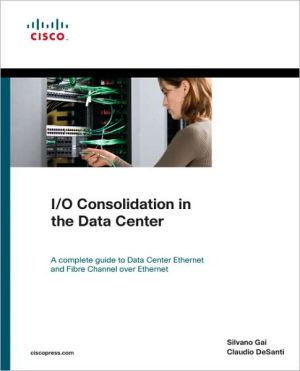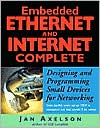Cisco LAN Switching Configuration Handbook
Search in google:
Cisco LAN Switching Configuration Handbook Second EditionA concise reference for implementing the most frequently used features of the Cisco Catalyst family of switchesSteve McQuerry, CCIE® No. 6108David Jansen, CCIE No. 5952David Hucaby, CCIE No. 4594Cisco LAN Switching Configuration Handbook, Second Edition, is a quick and portable reference guide to the most commonly used features that can be configured on Cisco® Catalyst® switches. Written to be used across all Catalyst IOS platforms, the book covers general use of Cisco IOS®, followed by a series of chapters that provide design and configuration guidelines. Each chapter starts with common design overviews and then describes the configuration of management features. Coverage includes Layer 2, Layer 3, multicast, high availability, and traffic management configurations.This book is organized by groups of common features, with sections marked by shaded tabs for quick reference. Information on each feature is presented in a concise format, with background, configuration, and example components. The format is organized for easy accessibility to commands and their proper usage, saving you hours of research time.From the first page, the authors zero in on quick facts, configuration steps, and explanations of configuration options in each Cisco Catalyst switch feature. The quick reference format allows you to easily locate just the information you need without having to search through thousands of pages of documentation, helping you get your switches up and running quickly and smoothly.Whether you are looking for a handy, portable reference to more easily configure Cisco Catalyst switches in the field, or you are preparing for CCNA®, CCNP®, or CCIE® certification, you will find Cisco LAN Switching Configuration Handbook, Second Edition, to be an essential resource.Steve McQuerry, CCIE No. 6108, is a technical solutions architect with Cisco focused on data center solutions. Steve works with enterprise customers in the midwestern United States to help them plan their data center architectures. David Jansen, CCIE No. 5952, is a technical solutions architect (TSA) with Cisco focused on Data Center Architectures at Cisco. David has more than 20 years of experience in the IT industry. David Hucaby, CCIE No. 4594, is a lead network engineer for the University of Kentucky, where he works with healthcare networks based on the Cisco Catalyst, ASA/PIX/FWSM security, and VPN product lines. Implement switched campus network designs Configure switch prompts, IP addresses, passwords, switch modules, file management, and administrative protocols Understand how Layer 3 interfaces are used in a switch Configure Ethernet, Fast Ethernet, Gigabit Ethernet, and EtherChannel interfaces Implement VLANs, trunking, and VTP Operate, configure, and tune Spanning Tree Protocol (STP) Handle multicast traffic and interact with multicast routers Streamline access to server and firewall farms with accelerated server load balancing Deploy broadcast suppression, user authentication, port security, and VLAN access lists Configure switch management features Implement QoS and high availability features Transport voice traffic with specialized voice gateway modules, inline power, and QoS featuresThis book is part of the Networking Technology Series from Cisco Press®, which offers networking professionals valuable information for constructing efficient networks, understanding new technologies, and building successful careers.
IntroductionChapter 1: CLI Usage1-1: Cisco Internetwork Operating System (IOS) SoftwareUsing Cisco IOS Software1-2: ROM MonitorUsing the ROM Monitor Command SetChapter 2: Switch Functionality2-1: Catalyst Switch FamiliesCatalyst 2000 SeriesCatalyst 3000 SeriesCatalyst 4500 SeriesCatalyst 65002-2: Switched Campus Network DesignsCatalyst Switch FamiliesCisco Validated Designs: CampusChapter 3: Supervisor Engine Configuration3-1: Prompts and BannersConfiguration of PromptConfiguration of BannerFeature Example3-2: IP Addressing and ServicesConfiguring an IP Management AddressConfiguring a Default GatewaySetting Up DNS Services or Host TablesConfiguring HTTP ServicesFeature Example3-3: Passwords and Password RecoveryConfiguration of PasswordsFeature ExamplePassword Recovery: Procedure 1Feature ExamplePassword Recovery on IOS Devices: Procedure 2Feature Example3-4: Managing ModulesViewing ModulesAccessing ModulesResetting ModulesPowering Modules Up and Down3-5: File Management and Boot ParametersNavigating File SystemsDeleting Files from FlashCopying System FilesFile System Boot ParametersAlias Commands3-6: Redundant SupervisorsForcing a Change to the Standby SupervisorSynchronizing IOS ImagesSynchronizing Boot Parameters3-7: Cisco Discovery ProtocolConfiguration of CDPFeature Example3-8: Time and CalendarSystem Time ConfigurationSetting the System Time ManuallySetting the System Time Through NTPExampleChapter 4: Layer 2 Interface Configuration4-1: Switching TableConfigurationDisplaying Information About the Switching TableSwitching Table Example4-2: Port SelectionConfigurationPort Selection Example4-3: EthernetConfigurationEthernet ExampleDisplaying Information About Layer 2 Interfaces4-4: EtherChannelConfigurationEtherChannel ExampleDisplaying Information About EtherChannelsChapter 5: Layer 3 Interface Configuration5-1: Layer 3 Switching5-2: Layer 3 Ethernet InterfacesConfigurationVerifying the ConfigurationFeature Example5-3: Layer 3 EtherChannelsConfigurationVerifying the ChannelFeature Example5-4: WAN InterfacesConfigurationConfiguring an Enhanced FlexWAN InterfaceConfiguring a SPA Interface Processor (SIP) / Shared Port Adapter (SPA)WAN InterfaceConfiguring a Packet-over-SONET InterfaceVerifying ConfigurationsFeature Example5-5: Layer 3 Virtual InterfacesConfiguring a VLAN InterfaceConfiguring SubinterfacesVerifying ConfigurationsFeature Example5-6: Routing TablesConfigurationVerifying RoutesChapter 6: VLANs and Trunking6-1: VLAN ConfigurationCreation of an Ethernet VLANFeature Example6-2: VLAN Port AssignmentsConfiguring Static VLANsConfiguring Dynamic VLANsVerifying VLAN Assignments6-3: TrunkingEnabling TrunkingSpecifying VLANs to TrunkVerifying TrunksFeature Example6-4: VLAN Trunking ProtocolEnabling VTP for OperationSetting VTP PasswordsChanging VTP ModesEnabling VTP PruningChanging VTP VersionsVerifying VTP OperationFeature Example6-5: Private VLANsConfiguring Private VLANsConfiguring Private Edge VLANsVerifying Private VLAN OperationFeature ExampleChapter 7: Spanning Tree Protocol (STP)7-1: STP OperationSTP ProcessSTP TiebreakersPath CostsSTP Port StatesSTP Topology ChangesImproving STP StabilitySTP Operation Example7-2: STP ConfigurationDisplaying Information About STPSTP Configuration ExamplesPoor STP Root PlacementSTP Load Balancing7-3: STP Convergence TuningConfiguring STP Convergence Tuning7-4: Navigating the Spanning-Tree TopologyChapter 8: Configuring High Availability Features8-1: Route Processor Redundancy (RPR/RPR+)ConfigurationDisplaying Information About RPR8-2: Non-Stop Forwarding/Supervisor Switchover (NSF/SSO) with SupervisorRedundancySSO/NSF ConfigurationDisplaying Information About SSO and NSF8-3: Router Redundancy with HSRPConfigurationHSRP ExampleDisplaying Information About HSRP8-4: Fast Software Upgrade (FSU) and Enhanced Fast Software Upgrade(eFSU)Chapter 9: Multicast9-1: Multicast Addressing9-2: IGMP SnoopingConfigurationIGMP Snooping ExampleDisplaying Information About IGMP SnoopingChapter 10: Server Load Balancing (SLB)10-1: SLBConfigurationSLB ExampleDisplaying Information About SLB10-2: SLB Firewall Load BalancingConfigurationFirewall Load-Balancing ExampleDisplaying Information About Firewall Load Balancing10-3: SLB ProbesConfigurationDisplaying Information About SLB ProbesChapter 11: Controlling Traffic and Switch Access11-1: Broadcast SuppressionConfiguring Broadcast SuppressionVerifying ConfigurationFeature Example11-2: Protocol FilteringConfigurationVerificationFeature Example11-3: Port SecurityConfigurationVerificationFeature Example11-4: VLAN Access Control ListsIOS VACL ConfigurationVerificationFeature Example11-5: Switch AuthenticationConfigurationVerificationFeature Example11-6: Access ClassConfigurationVerificationFeature Example11-7: SSH Telnet ConfigurationConfigurationVerificationFeature Example11-8: 802.1X Port AuthenticationConfigurationFeature Example11-9: Layer 2 SecurityPort SecurityFeature ExampleVerificationDHCP SnoopingFeature ExampleVerificationDynamic ARP InspectionFeature ExampleVerificationChapter 12: Switch Management12-1: LoggingConfigurationLogging ExampleDisplaying Information About Logging12-2: Simple Network Management ProtocolConfigurationSNMP ExampleDisplaying Information About SNMP12-3: Switched Port AnalyzerSPAN ConfigurationRSPAN ConfigurationSPAN ExamplesDisplaying Information About SPAN12-4: Power ManagementConfigurationDisplaying Information About Power Management12-5: Environmental Monitoring12-6: Packet TracingConfigurationPacket-Tracing ExampleChapter 13: Quality of Service13-1: QoS TheoryLayer 2 QoS Classification and MarkingLayer 3 QoS Classification and MarkingCatalyst Switch Queuing13-2: QoS ConfigurationCatalyst 2000/3000 ConfigurationAll Other Catalyst ConfigurationDisplaying Information About QoS13-3: QoS Data ExportConfigurationQoS Data Export ExampleDisplaying Information About QoS Data ExportChapter 14: Voice14-1: Voice PortsConfigurationExampleDisplaying Information About Voice Ports14-2: Voice QoSAccess Layer ConfigurationDistribution and Core Layer ConfigurationVoice QoS ExampleAppendix A: Cabling Quick ReferenceBack-to-Back ConnectionsEthernet ConnectionsAsynchronous Serial ConnectionsT1/E1 CSU/DSU ConnectionsAppendix B: Well-known Protocol, Port, and Other NumbersIndex
